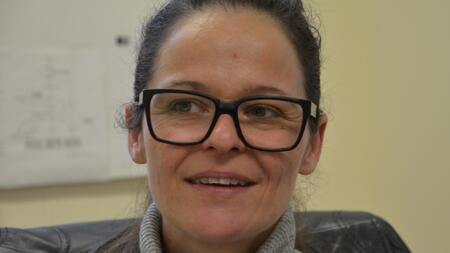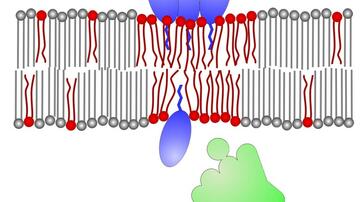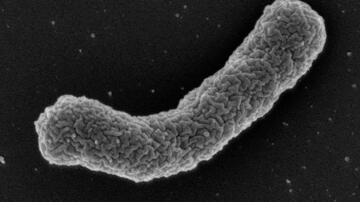Optimistic and Enduring
Tanja Schneider is greatly dedicated to searching for new active agents.
Dr Tanja Schneider has been researching the interactions of bacteria and antibiotics for over ten years. She knows almost all the antibiotic target sites and mechanisms of antibiotic action in detail. Since last year, she has been leading and sharing her knowledge with a DZIF Junior Research Group. She is greatly dedicated to searching for new active agents at the University of Bonn.
“We need new antibiotics urgently, the situation is critical,” the young researcher warns. More and more bacteria are becoming resistant to commonly used antibiotics, and less and less active agents are being developed by the pharmaceutical industry. “If things continue like this, we could soon find ourselves returning to a pre-antibiotic era,” Tanja Schneider fears. We already keep getting cases where antibiotics no longer help. But pessimism is not her thing, and when asked about the future of her research activities at the DZIF, her face lights up again quickly. “I am confident that we can find new active agents and target sites.” Schneider’s optimism is not without reason because she has been looking at targetable bacterial structures in precise detail over the last years.
The biologist investigated the function of a specific antibiotic in her diploma thesis at the Institute of Medical Microbiology and Immunology at the University of Bonn, and the topic has not let go of her since. In her subsequent doctoral thesis she went on to investigate the biosynthesis of bacterial cell walls in Staphylococcus aureus. The bacterial cell wall is one of the preferred target sites for many antibiotics for which it is highly suitable because it does not exist in this form in human cells. The big group of ß-lactam antibiotics, which includes penicillin, also inhibits cell wall synthesis and consequently leads to bacterial death.
“My doctoral thesis was purely fundamental research, which in the end provided us with a lot of information about potential target sites, which we need for investigating antibiotic mechanisms of action,” Tanja Schneider explains. So it is no surprise that after her doctoral thesis and further years of research in a postdoctoral position, she ventured into the pharmaceutical industry: As part of an EU project, she further researched the mechanism of action in the fungal defence peptide plectasin at the company Novozymes in Copenhagen for a few months. This venture into the pharmaceutical industry gave Tanja Schneider the experience and contacts that are also required for her research work at the DZIF—because DZIF’s top priority is to translate research into products.
Tanja Schneider’s Junior Research Group is part of the Thematic Translational Unit (TTU) “Novel Anti-Infectives” and they are now working on identifying new target sites for antibiotics. For this, the researchers are also concentrating on enzymes, structures and synthesis pathways which have previously not been targeted by antibiotics and could therefore bypass existing resistance mechanisms. In order to find new substances quickly, Tanja Schneider develops new, sensitive screening methods which test as many new substances as possible in a short period of time. The DZIF Natural Compound Library provides a large number of potential active substances from different laboratories and can deliver enough test substances for the screening. Tanja Schneider is enthusiastic, “This DZIF combination is absolutely unique. New extracts and sources are made available, and there have been no problems with information exchange between the experts from the different research institutions. I see a great potential for finding something new in this environment,” Tanja Schneider happily says. Her shining eyes reveal that “the fun has always been stronger than the frustration”, which can never quite be avoided during research work.
Her already established functioning screening system not only shows the antibiotic effects but also sheds light on the mechanism of action in the same test run. “Target-based screening did not bring new antibiotics to the market in the past,” the biologist explains. In her free time, the technophile researcher also likes to tinker with other tricky systems: Old timers and motorbikes are her hobbies.
Is there a reason why it’s always been Bonn? Tanja Schneider laughs: “Actually no, it is just how things developed with the projects. As soon as I ended one project, another one had somehow already materialized.” To further explain her endurance and absolute faithfulness to the topic of bacteria and antibiotics she adds, “I stick to things that work. As long as I have knowledge gaps to fill, I will continue.” And another reason is that surely no one would want to let go of her and her expertise, but she herself did not say this.
Besides establishing sensitive screening systems, Tanja Schneider and her team also pursue other strategies. One of them is the so-called combination therapy where commonly used antibiotics, such as ß-lactam antibiotics, are combined with other substances to boost their effect. In this way, existing resistances can be overcome and already resistant pathogens become sensitive to the antibiotic again. The researcher sees great potential in this because bacterial structures and pathways, such as cell wall synthesis, are extremely complex and interlinked. If you turn a screw in one place, it will have effects in other places.
Together with researchers from the company Merck, the Bonn researchers elucidated the mechanism of action for the new substance murgocil which is effective against MRSA strains (methicillin-resistant Staphylococcus aureus). These bacteria are dreaded hospital pathogens, because the traditional ß-lactam antibiotics no longer work against them. The researchers present murgocil in the journal ACS Chemical Biology (Volume 8/Issue 11, 2013): A small synthetic molecule which inhibits an enzyme involved in cell wall synthesis.
The bacterial cell wall has been used as a target site for active agents over and over again – Tanja Schneider sees many possibilities for finding new drugs. She is very sure, “Antibiotic agent research will never get boring.” And, true to her motto “never change a running system” she will continue as long as there is something left to discover in this field. That is fortunate for the German Centre for Infection Research.



